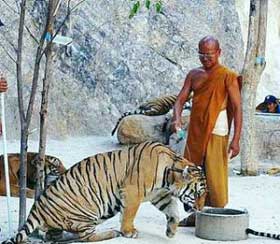PARADISE LOST
July 15, 2008
A report released by an animal welfare group alleges illegal trading of big cats at the Tiger Temple in Thailand.
Kanchanaburi, Thailand – It was touted as a paradise for man and beast – a rare place where both live in harmony. The stirring visual of a Buddhist monk clad in saffron robe walking with a big cat captivated millions around the world.
 << A monk at Tiger Temple spraying urine on a tiger to induce submission
<< A monk at Tiger Temple spraying urine on a tiger to induce submission
Many flocked to Wat Pa Luangta Bua Yannasampanno in Thailand to see for themselves how tigers which have been orphaned, rescued or donated to the temple are looked after, to be ultimately released into the wild.
But this conservation facade of the monastery in Kanchanaburi province, 322km north of Bangkok, has crumbled under the weight of a damning report released late last month by UK-based Care for the Wild International (CWI).
The report Exploiting the Tiger: Illegal Trade, Animal Cruelty and Tourists at Risk at the Tiger Temple, based on two years of investigation, prompted by concerns and information from tourists and volunteers at the temple, reveals the dark side of the popular tourist destination.
CWI claims that the temple, far from being a rescue centre, is operating as a commercial breeding establishment involved in the clandestine exchange of animals with a tiger farm in neighbouring Laos. In the 25-page report, CWI highlighted the suspicious appearance and disappearance of animals. It said investigators were told that at least seven tigers listed in the temple’s 2005 and 2007 brochures had disappeared, and at least five appeared without explanation.
“It is mostly older animals that were sent to Laos in exchange for young cubs,” says CWI chief executive Dr Barbara Maas in a press statement. “No one knows what happened to them there. These actions contravene both local and international laws under the Convention on International Trade in Endangered Species (Cites).
“Some of the new tigers were given the same names as animals that had been exported to Laos to obscure the fact that tigers are being moved in and out, and to perpetuate the impression that the temple provides rescued tigers with life-long care.”
A CWI investigator claimed to have witnessed in August 2005 the arrival of a cub later named Dao Ruang which the Abbot said had come from Laos “for the exchange of genes”. In return, adult male Payak was taken away.
Similarly, in April 2007, another investigator registered the replacement of two four-month-old female cubs with a pair of two-week-old male cubs.
The British conservation group notes that about 300 tourists visit the monastery each day and the number surged to almost 900 on busy days following the worldwide broadcast of the documentary The Temple of the Tigers on Animal Planet.
Discovery Channel, which produces Animal Planet, when contacted, says: “While it is not our policy to comment on ongoing investigations, the documentary The Temple of the Tigers has no future scheduled air dates on the Animal Planet television network.”
CWI points out that the tigers will not qualify for any conservation breeding programme: “Most of the animals there have either been bred on site or were brought in from the tiger farm in Laos. The genetic background of these animals is entirely unknown. All these animals are likely to be hybrids, which disqualifies them from participating in any conservation breeding programme seeking to rebuild wild populations.”
Tiger conservation biologist Dr Kae Kawanishi says the possibility of releasing these captive-born cubs into the forest of Thailand to reproduce is close to none.
“Breeding and rehabilitation of endangered species, especially of large carnivore species such as the tiger, needs to be based on systematic, scientifically controlled management of the captive populations.”
CWI investigation revealed that the monastery is not licensed to hold or breed tigers but because the Thai Government had no such facilities, the Department of National Parks in 2005 allowed the temple to keep the tigers but not to breed or trade the cats.
Investigators found 15 tigers living at the temple at any one time. The biggest attraction at the temple is its daily “Tiger Canyon” show where leashed tigers walk amongst tourists and are chained under the hot sun for some three hours. On top of the 300 baht (RM30) entrance fee, visitors pay a “donation” of 1,000 baht (RM100) to be photographed with a tiger. CWI estimated that the temple earns some 50 million baht (RM5mil) a year.
Apparently, these earnings do not benefit the very creature that brings in the money. CWI investigators documented squalid enclosures, sub-standard diet and poor veterinary care for the tigers. Local workers were photographed and filmed pulling, dragging and kicking the tigers.
To subdue the big cats, temple staff spray urine on the tigers’ faces, an act perceived by tigers as that of another aggressive and dominant animal.
In an interview in early January, temple abbot Pra Acharn Phusit Chan Khantitharo denied mistreating the animals and dismissed allegations of illegality, according to an initial unreleased report of CWI. This time around, calls to the temple went unanswered.
It is learnt that the authorities are hesitant to take action now, fearing that the temple would demand for compensation for taking care of the animals.
Nevertheless, CWI recommends confiscation and relocation of the tigers to a proper sanctuary, adding that it has identified a suitable facility in Thailand and is offering its support for this operation.
View the Care for the Wild International report at www.careforthewild.com
By HILARY CHIEW
Source : The Star




